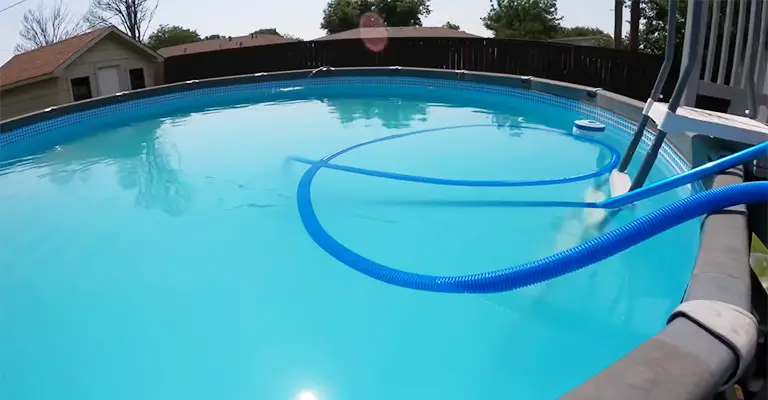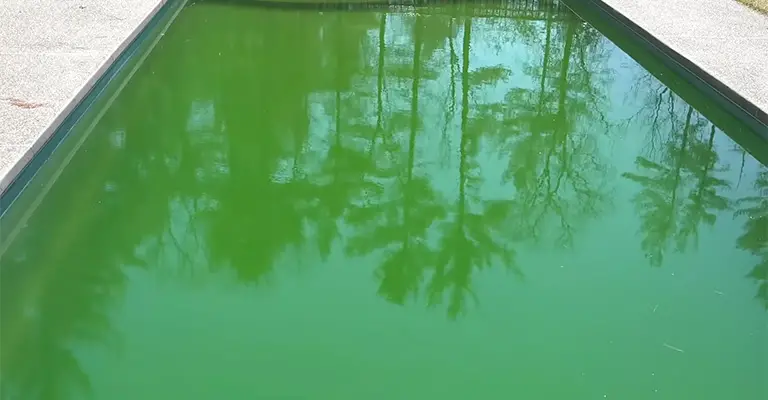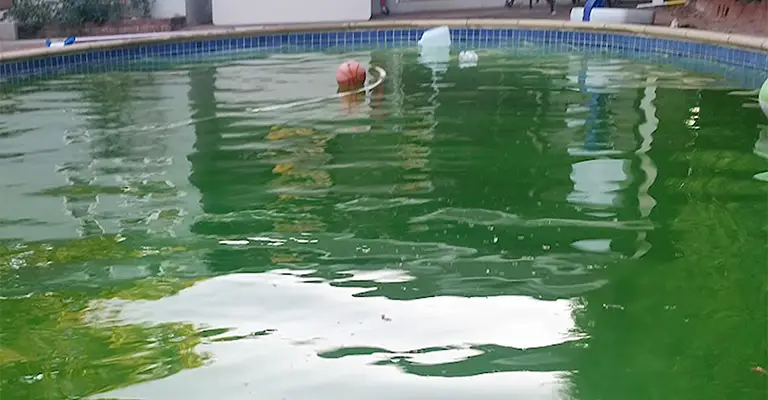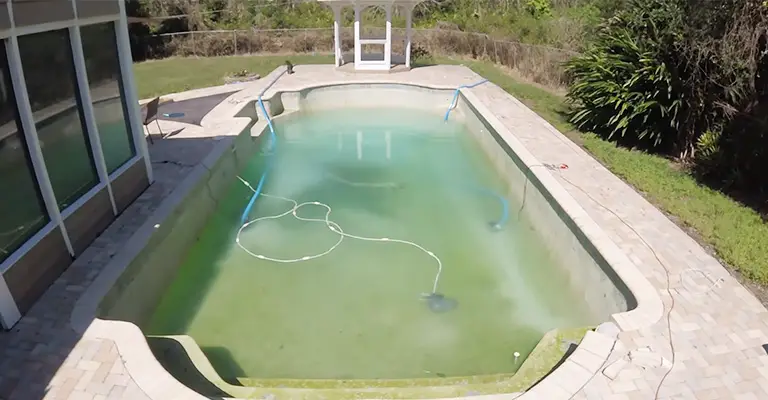How long is it okay to leave water in a pool without adding chlorine? If there’s no chlorine or other cleaners, bacteria and algae can start growing, and that’s not good for health.
Here’s a basic idea: In warm weather and sunlight, if it’s hot and the pool gets sun, bacteria and algae might start growing within 24 to 48 hours.
The length of time water can sit in a pool without chlorine depends on factors such as temperature, sunlight exposure, and debris or organic matter.
Without chlorine or other sanitizing agents, the water in a pool can become a breeding ground for algae, bacteria, and other microorganisms.
If the water is not adequately treated with chlorine or other disinfectants, it is recommended to change the water or apply appropriate sanitization within a week.
This timeframe ensures that the water remains safe and clean for swimming. However, it’s important to note that the specific conditions and quality of the water can influence this timeframe.
For example, if the pool is covered, kept in the shade, and free from debris, the water may last a bit longer without developing significant issues.
On the other hand, if the pool is exposed to direct sunlight and contaminants, the water quality may deteriorate more rapidly.
To maintain a healthy and safe pool, it’s generally recommended to regularly test and adjust the water chemistry, maintain proper filtration, and add appropriate disinfectants such as chlorine or alternative sanitizers as per the manufacturer’s instructions.
Just How Long Can Pool Water Sit Without Chlorine?

Most of the time, the water can evaporate until it evaporates. A swimming pool is estimated to lose its proper chlorine in 24 to 48 hours.
There are indeed products that will extend the life of chlorine, but I have not found that they have significant effects.
In the absence of rain, chlorine is removed from the water by evaporating the water’s surface. This may take several days if there is no rain.
There are a few factors that determine how long water can stay in a pool without chlorine. In untreated water without chlorine, bacteria and algae can grow, which may have harmful effects on health. This is a general idea:
In warm temperatures and sunlight: Within 24 to 48 hours after the swimming pool is exposed to sunlight, bacteria and algae begin to grow. The addition of chlorine is, therefore, important under such conditions.
In cooler temperatures or shaded areas: When the weather is cooler, or if the swimming pool is in a shaded area, the water should remain relatively straightforward for 3 to 5 days.
Although bacteria can grow in water under these conditions, the water can still become cloudy, making it unsuitable for swimming. Please remember that these timeframes are estimated, and the situation may differ in each pool.
Generally, keeping the right amount of chlorine in your pool is recommended for keeping the water clean and safe. Keeping water clear helps prevent the growth of harmful bacteria.
Ensure you take precautions if you don’t use the pool for some time. Using a pool cover can reduce the amount of sun exposure to the pool as well as the entry of debris into the water.
Furthermore, you may wish to consider installing an automatic pool sanitizer or chlorinator that constantly adds small amounts of chlorine.
Consider having someone check on your pool and add chlorine if necessary while you’re away.
Maintaining a swimming pool regularly, including testing and adjusting the chlorine level, ensures a safe and enjoyable experience.
What Happens If You Don’t Put Chemicals In Your Pool?

The recommendation is to add chemicals to your pool at least once a week and more frequently if the pool is commonly used.
It may be difficult for you to remedy this, and if you cannot do this, you may be wondering how long your pool can go without chemicals.
You can typically get away with not adding chemicals for a couple of weeks, depending on a couple of factors, such as your pool size, the weather, and the intensity of usage.
You will need to watch the water closely during this time, and you will need to add chemicals as soon as you notice any changes.
Green Algae

You’re used to seeing clean and pristine water in your pool, but if you stop using chlorine, you’ll see a green and unclean pool.
There is a possibility of algae growth in a pool, and it can occur in as little as 24 hours. Due to the fact that it’s in an open system, algae is less of a threat than in lakes and oceans.
It is important to note that a swimming pool is a closed system, which means that no new water is introduced, and no organisms eliminate bacteria around the algae.
As well algae are also not to blame for the problems, but rather the bacteria that feed on algae will cause your swimming pool to become a breeding ground for nasty bacteria like E. coli.
As a result, white and pink slimy molds can grow on your pool filtration system, which can eventually clog it and make it less efficient over time.
This leads to an increase in bacteria, as you might expect. It’s just the beginning of the process when it comes to green pools.
It Will Harbor Bacteria

If your pool water isn’t treated, it will harbor bacteria, which is one of the most severe consequences.
Depending on the growth rate, it can discolor water, cause bad odors, and potentially have adverse health effects. A pool left untreated can develop algae blooms.
Most pool chemicals contain chlorine, which is an oxidizer that destroys germs. Ensure that adequate chlorine is used and that chlorine is released at the right time and in the appropriate amount.
The risk of becoming ill when swimming in a pool that has not been chlorine treated is greater. It is one of the most important chemical components of pool water since chlorine is a powerful oxidizer that kills germs.
To reach the desired chlorine level, you must use enough chlorine, releasing it at the right time and amount.
Extensive Damage To The Pool
Additionally, improper water balance and bacterial buildup can damage the pool without chlorine.
When the water chemistry is not maintained, the pool liner can become damaged and eventually crack. Water with too low a pH can cause pitting, etching, and delamination in fiberglass pools due to the high acidity.
Aside from that, metal parts like screws, ladders, light fixtures, and pool cover components are also susceptible to corrosion.
It is essential to regularly test your water’s pH, alkalinity, and TDS to maintain the balance of these components. Also, make sure you clean the skimmer basket to facilitate proper circulation.
Should You Dump The Water Out After Each Use?

Even if you occasionally dip in the water without allowing chlorine to keep it sanitized, you should always dispose of the water afterwards.
If it were a large pool, this would be incredibly wasteful, but this would be far more feasible if it were a kiddie pool. Because children’s pools are smaller, replacing the water more often is acceptable.
Several owners of kiddie pools think a tarp can preserve the water overnight by covering the water overnight.
However, the tarp does not prevent bacteria from growing in the water, so it does not significantly extend the time the water remains clean.
Using chemicals to disinfect the water for larger pools will be necessary since dumping the water out is wasteful. Sadly, few chemicals can substitute chlorine perfectly, and chlorine is still needed in some instances.
Moreover, if you want to maintain a chemical-free pool, you must always replace the water after every use. Considering this is highly wasteful and uneconomical, this is not a good idea.
Can You Swim In A Pool Without Chemicals?
No matter how technically safe swimming in water without added chemicals is, it’s simply not a good idea to do it. The presence of bacteria, viruses, and parasites in chemical-free pools is a significant threat.
How Long Can Water Stay In the Swimming Pool?
To maintain the highest quality of your pool water, keep it in good condition. It is estimated that well-maintained pool water will last up to five or even seven years without needing to be replaced.
Basically, every day, you should conduct a pH test, clean the filters, and measure your pH.
The Bottom Line
Algae and fungi typically begin to grow in uncovered pools within 24–48 hours if no treatment is performed during the summer. It would start to look like a pond if you gave it a couple of weeks.







